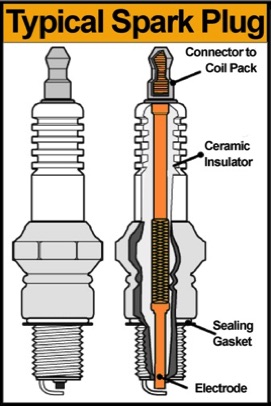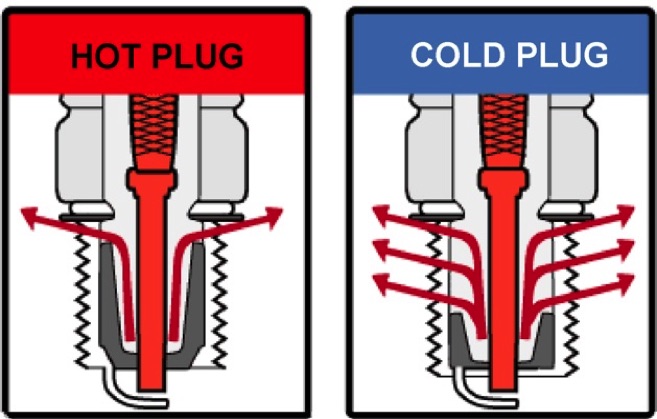
Published in the July 2012 issue of “Die Porsche Kassette”
The spark of life in any internal combustion gasoline engine comes from its Spark Plugs.
Spark plugs are foremost in your car’s ability to run and make power, yet they are one of the most overlooked and misunderstood components of the car.
So, let’s delve a little deeper into the subject.
The spark plug has two primary functions:
1.- To ignite the air/fuel mixture in the engine’s cylinders
2.- To remove heat from the combustion chamber
Spark plugs convert the energy contained in the fuel into dynamic energy in the engine. They do this by lighting a spark which sets off an explosion in each cylinder, making the pistons push into the crank, thus making it rotate.
The spark plug is quite a simple part, in theory.
It is a hollow piece of metal, threaded on one end, containing an isolated conductor running down its center.
It forces a high-voltage current initiated by the car’s ignition system (coils) to arc (jump) across a gap, just like a bolt of lightning does between the clouds and the earth.
This current must be at very high voltage in order to create the “lightning bolt” by jumping the gap. Voltage at the spark plug ranges between 12,000 and 25,000 volts although 45,000 volts is not uncommon.

In order for it to work, the spark plug needs an insulator that allows the current to travel down the electrode where it then can jump the gap and then run into the grounded engine block.
The plugs use an insulator, generally made of ceramic (porcelain) to isolate the high voltage running down the electrode, making sure that the spark happens at the tip of the electrode (inside the engine’s combustion chamber) and not anywhere else on the spark plug.
Ceramic is not a good heat conductor so the insulator gets quite hot during operation. This heat also helps burn off deposits on the electrode.
Depending on the type of engine, the manufacturer will select and recommend the correct temperature plug for each car. High performance engines, naturally generate more heat, so they need “colder” plugs. If the spark plug gets too hot, it could cause pre-ignition which is the lighting up of the fuel mixture before the spark happens, so it’s very important to follow the manufacturer’s recommendations for the correct plug to use.
Cars that require a “hot” plug must use the corresponding spark plug which is designed with a ceramic insert that has a larger contact area with the metal part of the plug.
This reduces the heat transfer from the ceramic insulator, making it run hotter and thus burn away more deposits.
“Cold” plugs are designed with less contact area so they dissipate more heat onto the engine block and run cooler.
The spark plug heat range has no relationship to the electrical energy transferred through the sparkplug. The heat range of the sparkplug is the range in which the plug works well thermally. The heat range of a sparkplug is generally designated by a number. Lower numbers indicate a hotter type, higher numbers indicate a colder type.

The heat range must be carefully selected for proper spark plug thermal performance. If the heat range is not optimal, then serious trouble can result. The optimal firing and temperature is approximately between 500°C (932°F) and 800°C (1472°F).
The two most common causes of spark plug problems are carbon fouling (< 450°C) and overheating (> 800°C).
Low heat range plugs have center electrode temps that rise easily and even at low speed, so they easily reach the self-cleaning temperature, so carbon is not deposited easily on the insulator section.
High heat range plugs have center electrode temps that do not rise easily, so they are unlikely to reach pre-ignition temps even at high speed.
That’s why it’s important to follow the manufacturer’s recommendations with the appropriate heat range for the engine characteristics, running conditions, etc.
Every time a spark plug fires, the hot spark blasts a few molecules of metal off the electrode. As the miles add up, the electrode gap widens and the center electrode becomes rounded and dull. This increases the firing voltage needed to jump the gap. Eventually the point is reached where the ignition system can’t generate enough juice to jump the gap, causing plugs to misfire. Because of this, spark plugs are wear items, and they must be replaced during regularly scheduled maintenance. Check your particular Porsche Owner’s Manual for the optimal replacement mileage (in a modern Porsche, generally between 60,000 – 100,000 miles).
The best advice for spark plugs is to inspect them every 30,000 miles.
This serves several purposes:
1.- It tells you a lot about how the engine is performing
2.- It prevents plugs from seizing in the engine block, causing expensive repairs.
Always note which cylinder a plug came from. This tells you if a particular cylinder has a problem.
The electrodes of modern spark plugs are now covered with exotic metals such as gold, palladium, platinum , iridium, etc. So, which one is best?
Here’s the skinny:
Platinum and iridium-coated plugs with a copper core won't boost horsepower or fuel economy; they'll just last longer and perform more consistently. Both platinum and iridium fine-wire plugs will outperform copper-tipped plugs, but the iridium's ability to withstand high temperatures allows for a thinner plug tip. In the real world, though, you're unlikely to see any measurable change in fuel economy using iridium instead of platinum plugs. Platinum will do everything iridium does outside of the most severe racing applications. Iridium can give engine builders a slight edge in very high-compression, turbocharged or supercharged engines, but this edge isn't likely to translate into increased fuel economy in a street engine.
Remember: Getting the heat range right is way more important than the type of metal used to coat the electrode. New spark plugs can make a difference in your Porsche’s performance, but only if replaced with the appropriate OEM replacement plug.
To learn about Spark Plugs and your Porsche in general, please visit my website at: www.Pedrosgarage.com.
Happy Porscheing,
Ⓒ2012 Technolab / PedrosGarage.com


